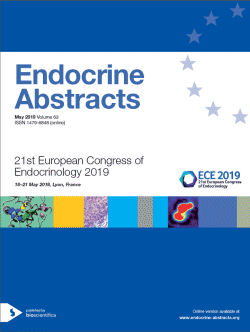
21st European Congress of Endocrinology
Lyon,
France
18 May 2019 - 21 May 2019
Oral Communications
Endocrine Connections 1
ea0063oc7.1 | Endocrine Connections 1 | ECE2019
Cortisol suppression or peripheral sensitivity and activation are associated with diabetes, hypertension and fragility fractures in postmenopausal eucortisolemic women
Aresta Carmen , Chiodini Iacopo , Gaudio Agostino , Eller-Vainicher Cristina , Morelli Valentina , Zhukouskaya Volha V , Merlotti Daniela , Orsi Emanuela , Barbieri Anna Maria , Fustinoni Silvia , Polledri Elisa , Gennari Luigi , Falchetti Alberto , Carnevale Vincenzo , Persani Luca , Scillitani Alfredo
ea0063oc7.2 | Endocrine Connections 1 | ECE2019
Thyroid hormones are new key regulators of glucocorticoid metabolism
Bessiene Laura , Hescot Segolene , Bourdin-Pintueles Alexandra , Dumeige Laurence , Vitellius Geraldine , Perrot Julie , Xu Qiong-Yao , Vu Thi-An , Sachs Laurent , Pussard Eric , Lombes Marc , Viengchareun Say , Martinerie Laetitia
ea0063oc7.3 | Endocrine Connections 1 | ECE2019
Higher dose of burosumab is needed for treatment of children with sever forms of X-linked hypophosphatemia
Zhukouskaya Volha V , Audrain Christelle , Lambert Anne-Sophie , Colao Annamaria , Kamenicky Peter , Adamsbaum Catherine , Nevoux Jerome , Chaussain Catherine , Wicart Philippe , Briot Karine , Rocco Federico Di , Trabado Severine , Prie Dominique , Rothenbuhler Anya , Linglart Agnes
ea0063oc7.4 | Endocrine Connections 1 | ECE2019
Non-invasive detection of GNAS mutations causing McCune-Albright Syndrome with ddPCR on whole blood or circulating DNA
Romanet Pauline , Philibert Pascal , Fina Frederic , Cuny Thomas , Reynaud Rachel , Paris Francoise , Barlier Anne
ea0063oc7.5 | Endocrine Connections 1 | ECE2019
Autoimmune polyendocrinopathy candidiasis ectodermal dystrophy (APECED) syndrome: French prospective study in a cohort of 25 patients
Humbert Linda , Dubucquoi Sylvain , Kemp Helen , Veber Pascale Saugier , Fabien Nicole , Top Isabelle Raymond , Bauters Catherine Cardot , Cartigny Maryse , Delemer Brigitte , Docao Christine , Penfornis Alfred , Guignat Laurence , Kerlan Veronique , Lefevbre Herve , Chabre Olivier , Vanhove Laura , Sendid Boualem , Carel Jean-Claude , Souchon Perre-Francois , Weil Jacques , Vantyghem Marie-Christine , Wemeau Jean-Louis , Proust-Lemoine Emmanuelle



